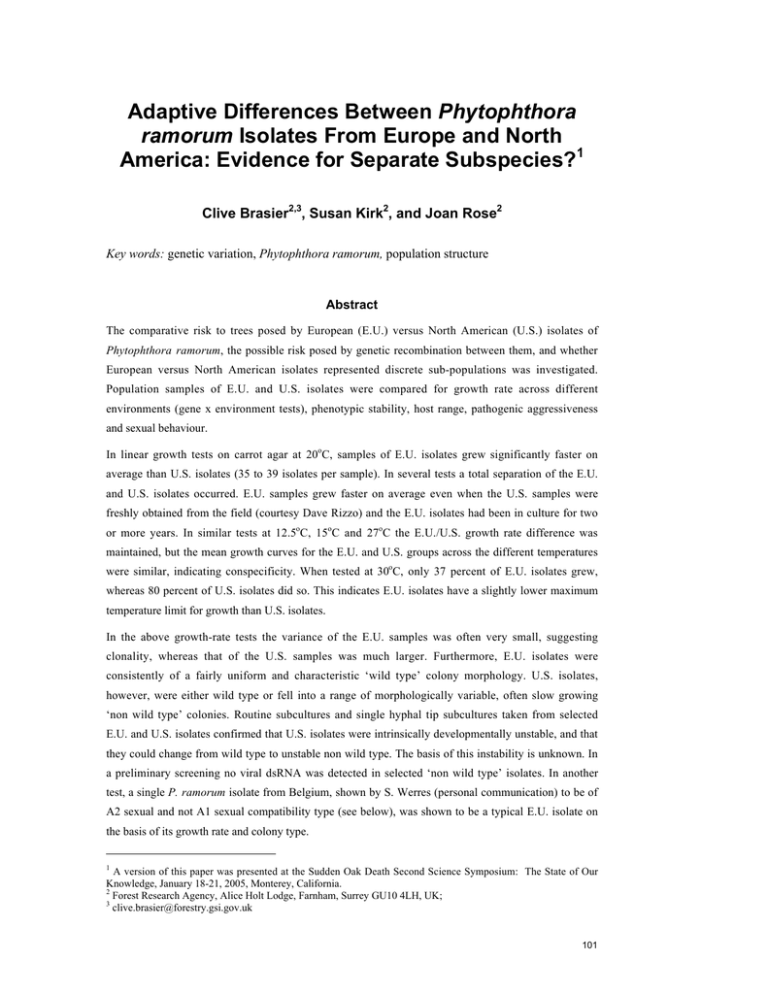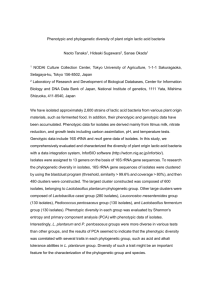Phytophthora America: Evidence for Separate Subspecies? ramorum Clive Brasier
advertisement

Adaptive Differences Between Phytophthora ramorum Isolates From Europe and North America: Evidence for Separate Subspecies?1 Clive Brasier2,3, Susan Kirk2, and Joan Rose2 Key words: genetic variation, Phytophthora ramorum, population structure Abstract The comparative risk to trees posed by European (E.U.) versus North American (U.S.) isolates of Phytophthora ramorum, the possible risk posed by genetic recombination between them, and whether European versus North American isolates represented discrete sub-populations was investigated. Population samples of E.U. and U.S. isolates were compared for growth rate across different environments (gene x environment tests), phenotypic stability, host range, pathogenic aggressiveness and sexual behaviour. In linear growth tests on carrot agar at 20oC, samples of E.U. isolates grew significantly faster on average than U.S. isolates (35 to 39 isolates per sample). In several tests a total separation of the E.U. and U.S. isolates occurred. E.U. samples grew faster on average even when the U.S. samples were freshly obtained from the field (courtesy Dave Rizzo) and the E.U. isolates had been in culture for two or more years. In similar tests at 12.5oC, 15oC and 27oC the E.U./U.S. growth rate difference was maintained, but the mean growth curves for the E.U. and U.S. groups across the different temperatures were similar, indicating conspecificity. When tested at 30oC, only 37 percent of E.U. isolates grew, whereas 80 percent of U.S. isolates did so. This indicates E.U. isolates have a slightly lower maximum temperature limit for growth than U.S. isolates. In the above growth-rate tests the variance of the E.U. samples was often very small, suggesting clonality, whereas that of the U.S. samples was much larger. Furthermore, E.U. isolates were consistently of a fairly uniform and characteristic ‘wild type’ colony morphology. U.S. isolates, however, were either wild type or fell into a range of morphologically variable, often slow growing ‘non wild type’ colonies. Routine subcultures and single hyphal tip subcultures taken from selected E.U. and U.S. isolates confirmed that U.S. isolates were intrinsically developmentally unstable, and that they could change from wild type to unstable non wild type. The basis of this instability is unknown. In a preliminary screening no viral dsRNA was detected in selected ‘non wild type’ isolates. In another test, a single P. ramorum isolate from Belgium, shown by S. Werres (personal communication) to be of A2 sexual and not A1 sexual compatibility type (see below), was shown to be a typical E.U. isolate on the basis of its growth rate and colony type. 1 A version of this paper was presented at the Sudden Oak Death Second Science Symposium: The State of Our Knowledge, January 18-21, 2005, Monterey, California. 2 Forest Research Agency, Alice Holt Lodge, Farnham, Surrey GU10 4LH, UK; 3 clive.brasier@forestry.gsi.gov.uk 101 GENERAL TECHNICAL REPORT PSW-GTR-196 In repeat tests for pathogenicity to bark on the susceptible host Quercus rubra (via wound inoculation and measurement of lesion area), samples of E.U. isolates were, on average, significantly more aggressive than U.S. isolates, though the ranges of the two groups always overlapped. An E.U. sample was more aggressive, on average, even when the U.S. isolates were freshly obtained from the field and the E.U. isolates had been in culture two or more years. The potential host ranges of E.U. and U.S. isolates were compared by wound inoculation of mature stems of about 30 European and North American trees. Comparisons were based on lesion sizes caused on different tree species. The host ranges of the E.U. and U.S. isolates were shown to be very similar, again indicating conspecificity. In standard sexual compatibility type tests on carrot agar, using A1- and A2-type testers of other Phytophthora species, samples of E.U. isolates were all of A1-type. Samples of U.S. isolates (excluding European-type nursery isolates from the Pacific Northwest) were all of A2-type (consistent with results obtained by other researchers). However, production of oogonia in these interspecific pairings was unusually slow, sparse and unpredictable. Also, using the same protocol, no oogonia could be obtained in pairings between the putative P. ramorum A1- and A2-types. Subsequently, a method was developed for producing oogonia of paired E.U. A1 x U.S. A2 P. ramorum isolates on carrot agar (Brasier and Kirk, 2004). Nonetheless, gametangial formation is still unusually sparse. Overall, it remains unclear whether P. ramorum is truly A1/A2 outcrossing or whether its sexual breeding system is functional. Conclusions: (1) E.U. and U.S. isolates exhibit many similarities in continuous variables indicating conspecificity. Equally, there are important differences between them for continuous variables, such as growth rate and aggressiveness. These are likely to reflect differences in fitness, in other words adaptive differences. They are further supported by differences in predominant sexual compatibility type, and by differences in molecular polymorphisms observed by other workers. (2) For the present, the E.U. and U.S. types should be considered distinct phenotypic populations. (3) Since the E.U. population exhibits both A1 and A2 sexual compatibility types i.e. it could potentially ‘breed true’. (4) The U.S. population exhibits greater phenotypic variation and unusual developmental instability. (5) If recombination (sexual or somatic) were to occur between the E.U. and U.S. populations, further additive allelic variation is likely to be generated, in other words there is a risk that recombination could lead to the generation of further adaptive variation. It is unclear at present how these phenotypic differences between the E.U. and U.S. populations came about. Three possible explanations are suggested: (A) That the E.U. and U.S. types are part of an original, far more variable gene pool in P. ramorum’s center of origin. Their differences reflect a combination of genetic bottlenecks during their introduction and the different selection pressures the two populations have experienced since their introduction into the E.U. and the United States. For example, growth rate variation in the E.U. population is narrow because this population has been subject to intense directional or stabilising selection within the European nursery environment. Growth rate variation in the U.S. population is broader because it has been exposed to a more heterogeneous set of environments or selection pressures in U.S. forests. (B) That the differences reflect their prior adaptation, before their introduction into the E.U. and United States. In other words, there may be two different ‘source’ populations of P. ramorum, for example in China or wherever P. ramorum originated (Brasier and others 2004). (C) A combination of (A) and (B) (A and B are not mutually exclusive). 102 Proceedings of the sudden oak death second science symposium: the state of our knowledge Our current view is that process A is, by far, the most likely explanation. If process B were to be confirmed, however, we might need to reconceptualise the E.U. and U.S. population types as two (partially reproductively isolated?) subspecies of P. ramorum, for example as P. ramorum subspecies europaea and subspecies americana. References: Brasier, C.M. and Kirk, S.A. 2004. Production of gametangia by Phytophthora ramorum in vitro. Mycological Research 108, 823–27. Brasier, C.M.; Denman, S.; Brown, A.V.; and Webber, J.F. 2004. Sudden Oak Death (Phytophthora ramorum) discovered on trees in Europe. Mycological Research 108, 1108–1110. 103








